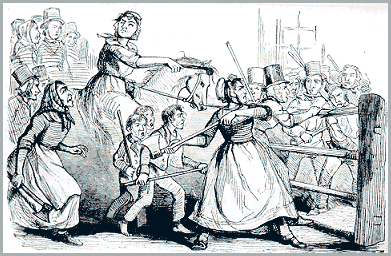|
Talog, Carmarthenshire
Talog is a small rural village in Carmarthenshire, located on the River Cywyn, about seven miles north-west of the town of Carmarthen, Wales. It is in the community of Abernant. Talog was one of many west Wales villages involved in the Rebecca Riots of the early 19th century. A local miller, John Harries, was tried for his involvement in an ambush of the police and army pensioners at Talog, on 12 June 1843, after a reward of £300 had been offered for his capture. Sentenced along with him were two other local men, Thomas Thomas and Sam Brown. The village store was originally set up in 1836 by Thomas Thomas, and incorporated a post office. The village is now served by a mobile Post Office which visits 2 days a week. Bethania Baptist Church was built in 1839. A First World War building, purchased from the War Department in Monmouth, was brought to the village and set up for use as a village hall in 1920. Talog is the home of Jin Talog, a small gin distillery Distillation, ... [...More Info...] [...Related Items...] OR: [Wikipedia] [Google] [Baidu] |
Carmarthenshire
Carmarthenshire ( cy, Sir Gaerfyrddin; or informally ') is a county in the south-west of Wales. The three largest towns are Llanelli, Carmarthen and Ammanford. Carmarthen is the county town and administrative centre. The county is known as the "Garden of Wales" and is also home to the National Botanic Garden of Wales. Carmarthenshire has been inhabited since prehistoric times. The county town was founded by the Romans, and the region was part of the Kingdom of Deheubarth in the High Middle Ages. After invasion by the Normans in the 12th and 13th centuries it was subjugated, along with other parts of Wales, by Edward I of England. There was further unrest in the early 15th century, when the Welsh rebelled under Owain Glyndŵr, and during the English Civil War. Carmarthenshire is mainly an agricultural county, apart from the southeastern part which was once heavily industrialised with coal mining, steel-making and tin-plating. In the north of the county, the woollen industr ... [...More Info...] [...Related Items...] OR: [Wikipedia] [Google] [Baidu] |
Ordnance Survey
, nativename_a = , nativename_r = , logo = Ordnance Survey 2015 Logo.svg , logo_width = 240px , logo_caption = , seal = , seal_width = , seal_caption = , picture = , picture_width = , picture_caption = , formed = , preceding1 = , dissolved = , superseding = , jurisdiction = Great BritainThe Ordnance Survey deals only with maps of Great Britain, and, to an extent, the Isle of Man, but not Northern Ireland, which has its own, separate government agency, the Ordnance Survey of Northern Ireland. , headquarters = Southampton, England, UK , region_code = GB , coordinates = , employees = 1,244 , budget = , minister1_name = , minister1_pfo = , chief1_name = Steve Blair , chief1_position = CEO , agency_type = , parent_agency = , child1_agency = , keydocument1 = , website = , footnotes = , map = , map_width = , map_caption = Ordnance Survey (OS) is the national mapping agency for Great Britain. The agency's name indicates its original military purpose (se ... [...More Info...] [...Related Items...] OR: [Wikipedia] [Google] [Baidu] |
River Cywyn
The River Cywyn (Welsh ''Afon Cywyn'') is a river that flows through Carmarthenshire, south Wales. It rises some seven miles west-north-west of Carmarthen and flows in a southerly direction to join the River Tâf The River Taf ( cy, Afon Taf) is a river in West Wales. It rises in the Preseli Hills, Pembrokeshire, and continues through Carmarthenshire to Laugharne. It is one of the three rivers to enter the sea on the east side of Carmarthen Bay. The oth ... near its estuary. Cywyn {{Wales-river-stub ... [...More Info...] [...Related Items...] OR: [Wikipedia] [Google] [Baidu] |
Carmarthen
Carmarthen (, RP: ; cy, Caerfyrddin , "Merlin's fort" or "Sea-town fort") is the county town of Carmarthenshire and a community in Wales, lying on the River Towy. north of its estuary in Carmarthen Bay. The population was 14,185 in 2011, down from 15,854 in 2001, but gauged at 16,285 in 2019. It has a claim to be the oldest town in Wales – ''Old Carmarthen'' and ''New Carmarthen'' became one borough in 1546. It was the most populous borough in Wales in the 16th–18th centuries, described by William Camden as "chief citie of the country". Growth stagnated by the mid-19th century as new settlements developed in the South Wales Coalfield. History Early history When Britannia was a Roman province, Carmarthen was the civitas capital of the Demetae tribe, known as Moridunum ("Sea Fort"). It is possibly the oldest town in Wales, recorded by Ptolemy and in the Antonine Itinerary. The Roman fort is believed to date from about AD 75. A Roman coin hoard was found nearby in 20 ... [...More Info...] [...Related Items...] OR: [Wikipedia] [Google] [Baidu] |
Abernant, Carmarthenshire
Abernant is a community in Carmarthenshire, Wales. The population taken at the 2011 census was 297. Location Abernant is a small hamlet located four miles north west of the traditional county town of Carmarthen. The community is bordered by the communities of: Cynwyl Elfed; Newchurch and Merthyr; Meidrim; and Trelech, all being in Carmarthenshire. History & Amenities It has a parish church and a small primary school. Abernant has the oldest and vastest graveyard in Wales. Abernant is situated near Talog, Bwlchnewydd and Cynwyl Elfed, all of which have more facilities than Abernant. Abernant used to have a pub and a post office A post office is a public facility and a retailer that provides mail services, such as accepting letters and parcels, providing post office boxes, and selling postage stamps, packaging, and stationery. Post offices may offer additional ser ..., but due to the ever-decreasing number of residents these no longer exist. References ... [...More Info...] [...Related Items...] OR: [Wikipedia] [Google] [Baidu] |
Rebecca Riots
The Rebecca Riots (Welsh: ''Terfysgoedd Beca'') took place between 1839 and 1843 in West and Mid Wales. They were a series of protests undertaken by local farmers and agricultural workers in response to levels of taxation. The rioters, often men dressed as women, took their actions against toll-gates, as they were tangible representations of taxes and tolls. The rioters went by the name of 'Merched Beca' which translates directly from Cymraeg as Rebecca's Daughters. The riots ceased prior to 1844 due to several factors, including increased troop levels, a desire by the protestors to avoid violence and the appearance of criminal groups using the guise of the biblical character Rebecca for their own purposes. In 1844 an Act of Parliament to consolidate and amend the laws relating to turnpike trusts in Wales was passed. History Events leading to the riots In the late 1830s and early 1840s, the agricultural communities of west Wales were in dire poverty.Howell (1988), pg, 113 In 1 ... [...More Info...] [...Related Items...] OR: [Wikipedia] [Google] [Baidu] |
First World War
World War I (28 July 1914 11 November 1918), often abbreviated as WWI, was one of the deadliest global conflicts in history. Belligerents included much of Europe, the Russian Empire, the United States, and the Ottoman Empire, with fighting occurring throughout Europe, the Middle East, Africa, the Pacific, and parts of Asia. An estimated 9 million soldiers were killed in combat, plus another 23 million wounded, while 5 million civilians died as a result of military action, hunger, and disease. Millions more died in genocides within the Ottoman Empire and in the 1918 influenza pandemic, which was exacerbated by the movement of combatants during the war. Prior to 1914, the European great powers were divided between the Triple Entente (comprising France, Russia, and Britain) and the Triple Alliance (containing Germany, Austria-Hungary, and Italy). Tensions in the Balkans came to a head on 28 June 1914, following the assassination of Archduke Franz Ferdina ... [...More Info...] [...Related Items...] OR: [Wikipedia] [Google] [Baidu] |
Distillery
Distillation, or classical distillation, is the process of separating the components or substances from a liquid mixture by using selective boiling and condensation, usually inside an apparatus known as a still. Dry distillation is the heating of solid materials to produce gaseous products (which may condense into liquids or solids); this may involve chemical changes such as destructive distillation or cracking. Distillation may result in essentially complete separation (resulting in nearly pure components), or it may be a partial separation that increases the concentration of selected components; in either case, the process exploits differences in the relative volatility of the mixture's components. In industrial applications, distillation is a unit operation of practically universal importance, but is a physical separation process, not a chemical reaction. An installation used for distillation, especially of distilled beverages, is a distillery. Distillation includes the f ... [...More Info...] [...Related Items...] OR: [Wikipedia] [Google] [Baidu] |
Wales Online
Media Wales Ltd. is a publishing company based in Cardiff, Wales. As of 2009 it was owned by Reach plc (formerly known as the Trinity Mirror Group). It was previously known as the Western Mail & Echo Ltd. History The ''Western Mail'' was founded in 1869 by the 3rd Marquess of Bute as a Conservative newspaper. In 1893, the original building in St. Mary Street was destroyed by fire and a new building was opened also in St Mary Street two years later. In 1928 the Western Mail Ltd amalgamated with David Duncan & Sons, who published the ''South Wales Daily News'' and the ''South Wales Echo'', which was established in 1884. The merged company became Western Mail and Echo Ltd. and because of the merger ''Evening Express'' and ''South Wales Daily'' News closed. In 1960, the newspapers left St Mary Street and moved to Thomson House, Cardiff. On 1 October 2007 Western Mail and Echo Ltd changed its name to Media Wales, and in 2008 Media Wales moved from Thomson House in Havelock Str ... [...More Info...] [...Related Items...] OR: [Wikipedia] [Google] [Baidu] |





